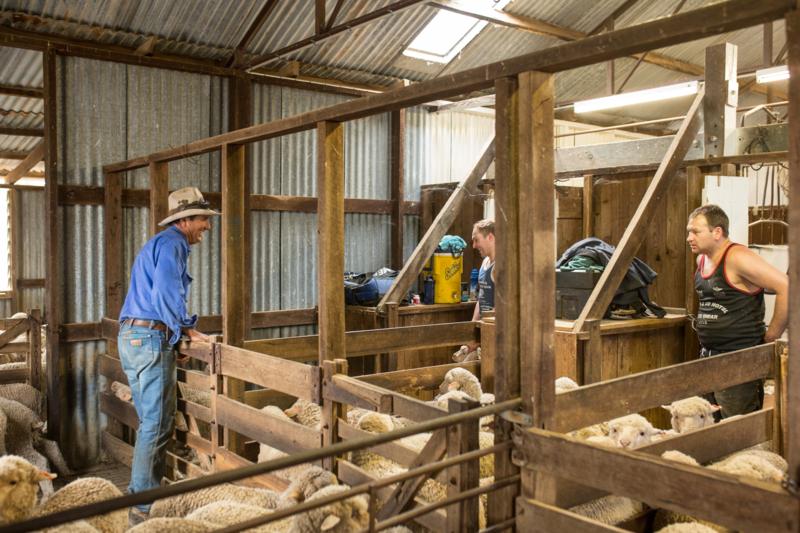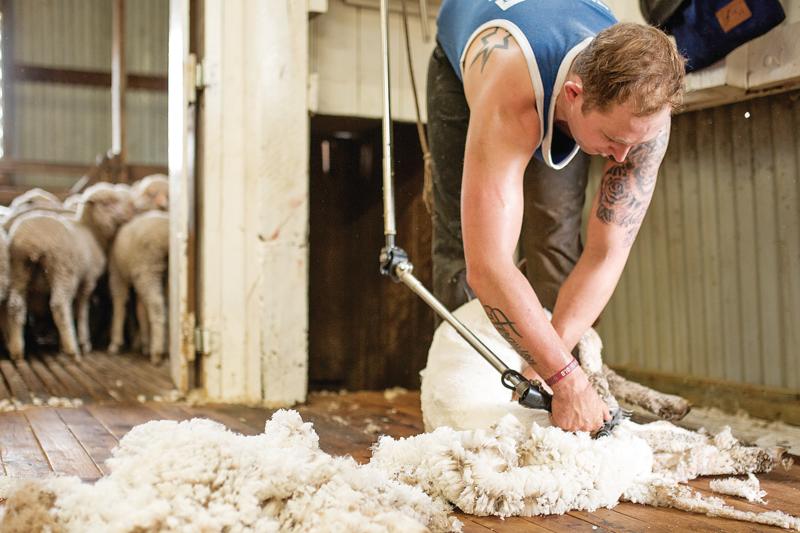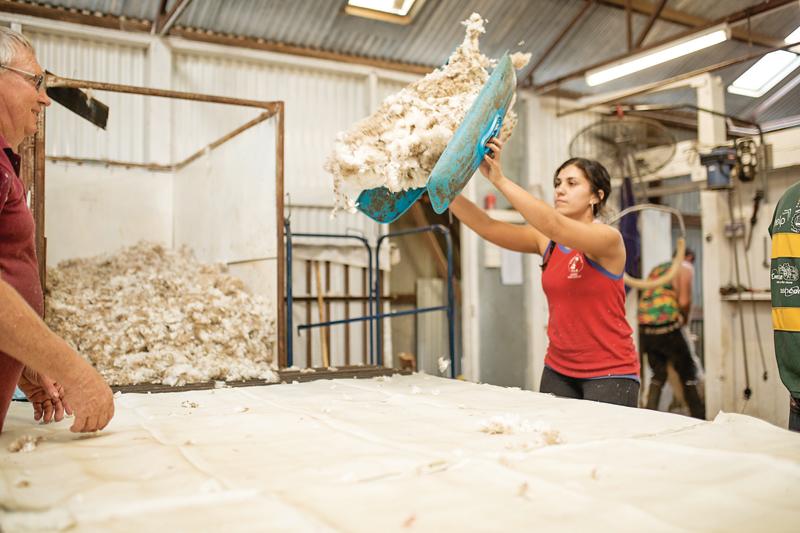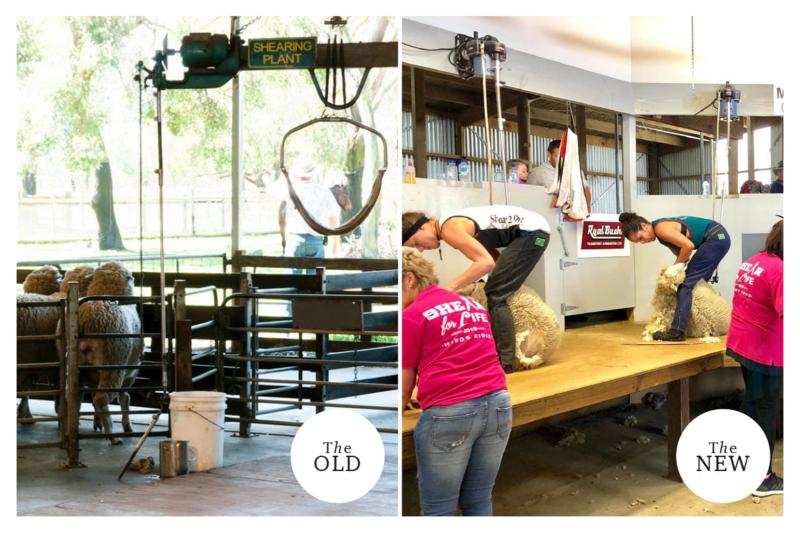SHEARING sheds can be dangerous places, especially if they have not been upgraded in recent times. The reality of this was brought to light by a tragic accident involving a young woman suffering serious head injuries in November 2017.
SafeWork NSW is investigating the incident, which involved the woman’s hair being caught in the driveshaft of an old overhead shearing plant.
NSW Farmers and
SafeWork NSW are encouraging farmers and everyone involved in shearing to be mindful of a wide range of health and safety concerns around shearing sheds.
NSW Farmers’ Wool Committee member Callan Schaefer farms at Guyra in the NSW Northern Tablelands and also works for a contractor shearing and crutching in the area. Callan says he upgraded his own shed after he heard about the incident involving the young woman.
“I got rid of my overhead shafts and replaced them with new electronic gear,” Callan says. “It cost me about $8,000 because I only have a small shed – they’re about $2,000 a shaft to replace. Most sheds I go to now have the new gear, but I do know of sheds that are still using overhead shafts.”
 Many farmers like Callan Schaefer and Peter McCrabb (pictured left) place a big emphasis on ensuring shearers are using safe equipment and have comfortable facilities. Photo by: Chantel McAlister.
Many farmers like Callan Schaefer and Peter McCrabb (pictured left) place a big emphasis on ensuring shearers are using safe equipment and have comfortable facilities. Photo by: Chantel McAlister.
While high wool prices have helped farmers find the money to invest in upgrading sheds, Callan says the drought has worked against them.
“Nobody thinks of upgrading when you are just trying to keep the sheep alive and keep stock on the farm,” he says. “People are phasing out overhead shafts. Otherwise they just put a guard up to improve the safety.”
RELATED ARTICLES ON DROUGHT:
-
Drought declarations: for or against?
-
The truth about the Murray-Darling
-
Building resilience to drought
-
Climate change wreaking havoc
Shearing shed inductions to help increase safety
Callan says that one of the ways shearing shed safety can be improved is by doing an induction when work starts at a shed to make sure everyone knows the dangers and how to avoid them.
“That is something we can definitely improve in the industry,” he says.
RELATED ARTICLES ON SHEEP FARMING:
-
Sustainable Merino farm turns to perennials
-
The sheep farmers succeeding with genetics
-
The Merino farmer bucking tradition
-
Cashing in on the wool boom
While safety is high on the list of priorities for improving sheds, amenity and health considerations are also on the agenda. Callan says all sheds should have easy access to flushing toilets and SafeWork NSW agrees.
“It’s not good enough to tell people to head out the back of the shed or go behind a bush these days,” says a spokesperson in a statement from SafeWork NSW.
“Sheds need to have fresh drinking water and, if needed, accommodation should be provided for women as well as men, while showers should have hot and cold water.”
While this sounds prescriptive, the statement from SafeWork stresses its shearing shed safety project is not only about instituting compliance, but is focusing on liaison and raising awareness.
 The new generation of shearers should expect flushing toilets and fresh drinking water. Many farmers are now improving amenities and working conditions. Photo by: Chantel McAlister.
The new generation of shearers should expect flushing toilets and fresh drinking water. Many farmers are now improving amenities and working conditions. Photo by: Chantel McAlister.
“We are planning on meeting with a wide range of stakeholders involved in the industry to work out what is best practice, including what’s the best way to make the job easier and what can we do to help farmers to provide for that. We’ll review our guide but we won’t reinvent the wheel. We are very mindful that a lot of our shearing contractors work across the boundaries of NSW/Victoria/ACT and NSW/Queensland, so we are very interested to hear what the industry has to say.”
Shed design is particularly important and will be looked at as part of the project. The SafeWork spokesperson says there are some simple things that can make a big difference.
“If the slats in catch pens don’t run in the direction the shearer will drag the sheep, it’s much harder. That’s a lot of unnecessary physical strain and this can lead to injury.” – SafeWork NSW
“Musculoskeletal injuries are the greatest initiator of workers compensation claims and worker downtime in the shearing industry and shed design plays a huge role in minimising these types of injuries. But guarding is also an issue. New electronic equipment can be safer and has the potential to be more ergonomically friendly for the user.”
NSW Farmers’ Wool Committee chair Andrew Wood says it is important to encourage people to update without being prescriptive about what they should do.
“We’ve got a big problem in the industry with attracting young people,” he says. “When we do get good people in, we need to do things to keep them. We need to improve facilities.”
RELATED: Why is there a shortage of shearers?
 Attracting young people is a big priority for the shearing industry. Photo by: Chantel McAlister.
Attracting young people is a big priority for the shearing industry. Photo by: Chantel McAlister.
Andrew, who farms near Armidale, says in his own experience, he found his old shearing shed simply wasn’t good enough after expanding his operation, so he took action.
“We bought some more country and doubled the number of sheep we were running. We needed better facilities. We built a smoko room that cost us $6,000 and it has made a huge difference to worker comfort.
“We got rid of our shaft system a long time ago and are looking now to go to
[Heiniger] Evo gear. It gives a better cut and there’s less fatigue for shearers. It’s hard work as it is, you don’t want to make it harder. You need to look after people.
 Old-style overhead shaft-driven shearing plants (left) are being phased out in favour of the safer, modern electronic shearing equipment, which has guards and automatic safety switches. Source: Alamy
Old-style overhead shaft-driven shearing plants (left) are being phased out in favour of the safer, modern electronic shearing equipment, which has guards and automatic safety switches. Source: Alamy
“While we can provide the best possible gear, there is also a big part of it that comes down to personal responsibility. Some assistance would also help,” says Andrew.
The shearing shed safety project will run until 2022.
SafeWork NSW’s small business rebate program offers up to $500 to farmers who make safety improvements to their shearing shed, such as replacing old gear with a new electric plant or installing guarding on overhead gear to eliminate entanglement risks.
Shearing shed safety signs are available from Australian Wool Innovation. Packs of 36 signs, with 22 different messages such as ‘exit’ and ‘first aid’ that meet Australian Standards are available for delivery within Australia for $25. Go to
wool.com and search ‘safety signs’.
Shearing safety tips from SafeWork NSW
⚠️Ensure guards are on all shearing machinery including grinders.
⚠️Space your workers out to avoid clashing of down-tubes.
⚠️Use electric motors on wool presses to reduce noise and ensure they are fitted with a safety bar and emergency stop switch.
⚠️Regularly maintain all equipment and have safety equipment in place.
⚠️Keep all walkways clear.
⚠️Make sure emergency stop buttons can be easily reached.
⚠️Make sure catching pen floors are dry and non-slip and battens are aligned with the direction of drag.
⚠️Keep sheep to be sheared dry.
⚠️Maintain good posture and use your legs instead of your back when moving sheep.
⚠️Keep other workers, children and dogs out of the shed.
⚠️Have an accessible first aid kit.
⚠️Ensure the shed is well ventilated and install fans as required.
⚠️Regularly check and maintain firefighting equipment.
⚠️Train new workers and visitors in shearing shed safety.
⚠️Ensure all workers are screened and vaccinated for Q fever and other zoonotic diseases.
⚠️Allow for left-handed shearers to ensure there are no reverse drag issues.